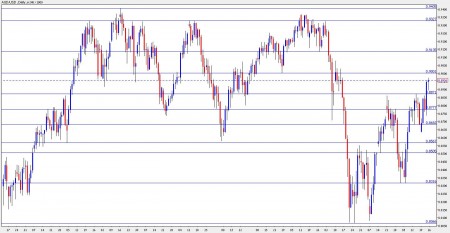Key inflation figures will rock the Aussie in the upcoming week. Here’s an outlook for the Australian events and an updated technical analysis for AUD/USD.
AUD/USD chart with support and resistance lines on it. Click to enlarge:
In a rather calm week, the Aussie rose, enjoying the basic advantages of the economy, with the great employment situation shining. This week, the focus will be on the next rate decision:
- PPI: Published on Monday at 1:30 GMT. Producer prices, like consumer prices, are released only once per quarter in Australia, making it a very important release. In the first quarter, prices surprised with a jump of 1%, significantly higher than expected. The recent rise in commodity prices will probably trigger a rise of 1.5% in producer prices this quarter.
- CB Leading Index: Published on Tuesday at 1:00 GMT. The Conference Board creates this index out of 7 economic indicators with many of them already released. Nevertheless, the release still impacts the Aussie, especially as it’s released as the week begins. After two months of small rises (0.3% and 0.1%), it’s now expected to remain unchanged.
- CPI: Published on Wednesday at 1:30 GMT. This major event will set the tone for the next rate decision, and will rock the Aussie. Q1 saw consumer prices rise by 0.9%, exactly as expected. This triggered the recent pauses in rate hikes. This time, inflation is expected to be similar, with a rise of 1%. A surprising jump will force a rate hike in the near future. Also note the Trimmed Mean CPI (Core CPI in other countries), which is expected to rise by 0.8%, similar to other countries.
- Private Sector Credit: Published on Monday at 1:30 GMT. More credit in the private sector means more economic activity. Credit has been expanding in the past 7 months, with a strong 0.5% rise last month. Another expansion is expected this time, but it will probably be more modest – 0.4%.
AUD/USD Technical Analysis
The Aussie continued falling at the beginning of the new week, including a Sunday gap. This gap, at the 0.8660 line, was closed quickly and the pair began rising, jumping above 0.8770 and struggling at 0.8870. But also this line was breached and the pair bounced only upon approaching the round number of 0.90. All in all, the pair made almost 200 pips in the past week.
Note that some of the lines have changed since last week’s outlook. The Aussie is now bound between 0.8870 which turned into a strong line of support, and 0.90, which is a round number which was a swing low in March.
Above, 0.9135 served as a strong support line when the pair was trading higher, and works as a resistance line. Higher, 0.9327 capped the pair many times in 2009 and at the beginning of 2010, and works as a strong line of resistance. Even higher, 0.9405, the 2009 high is the last line of resistance for now.
Looking down below 0.8870, the 0.8770 line provides minor support, and it’s followed by 0.8660, the gap line which also supported the pair beforehand.
Below, we find the 0.8567 line, which worked as a decisive line in the past, mostly as a support line. Below, 0.85000 is another minor line, followed by 0.8316, a double bottom at the beginning of July. The year-to-date low of 0.8066 is the last line.
I remain bullish on the Aussie.
The strong Australian fundamentals, such as the booming job market, will probably receive a boost from inflation figures, triggering another rate hike and more gains for AUD/USD.
Further reading:
- For a broad view of all the week’s major events worldwide, read the USD outlook.
- For EUR/USD, check out the Euro/Dollar Forecast.
- For GBP/USD (cable), look into the British Pound forecast.
- For the New Zealand dollar (kiwi), read the NZD/USD forecast.
- For USD/CAD (loonie), check out the Canadian dollar forecast.
Want to see what other traders are doing in real accounts? Check out Currensee. It’s free..

